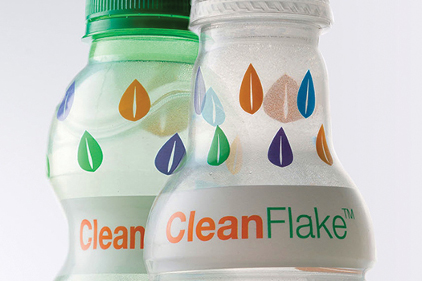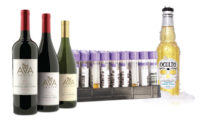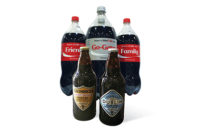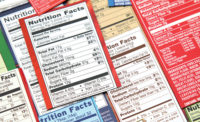What is a label?

It does not seem long ago that labels on beverages were simply the means by which the consumer would find the product name, a brief description of its weight or volume, a few details of its contents and, possibly, a list of ingredients. Now, that is far from the case. Seen as a fundamental element of the beverage package, the label is identified by marketing departments across the world as a vital interface with the end user, assisting in the creation of brand identity and reinforcing the product’s position in the mind of the consumer and in the marketplace.
Beverage manufacturers are not only looking to labeling as a method of establishing their brands, however. As with many other manufacturing industries, the beverage industry is also looking to its labeling capabilities for greater efficiencies and ever lower total costs of equipment ownership. Again, in common with many other industries, beverage producers also have a much greater focus on sustainability and reducing the environmental impact and emissions associated with manufacturing.
Sustainable labeling
Beverage producers are continually looking to maximize profits by lowering their costs across the board, from the consumption of raw materials to the overheads of routine maintenance and service. By reducing label thickness, companies can significantly cut the total amount of resources needed to create labels for the many millions of liters of beverages bottled annually. Consequently, suppliers of labeling solutions are also working to ensure that thinner labels can be handled by the latest labeling equipment technologies, and to ensure that the label adhesives do not affect the viability of the bottle recycling process.
The recycling of PET bottles has been hindered in the past as the label itself or the glues used to secure it in place have jeopardized the use of the recycled material in food-grade applications. Developments in Japan, however, are underway to resolve these recycling road blocks, including the creation of a glue that adheres only to the label and not to the wall of the bottle when the label is peeled off, and the design of shrink-labels with perforations, which facilitate the easy removal of the label by the consumer before the bottle is tossed in the recycling bin.
Some labeling solutions are greatly reducing the amount of glue required, or moving away from the use of adhesives altogether, for reasons of economy and sustainability. Yet, aside from the environmental and commercial benefits, there are also very practical reasons for the shift away from adhesives. One such practical consideration is that the greater the amount of glue used, the greater its detrimental impact on the efficiency of the labeling equipment. By moving towards methods of label application that do not employ any form of glue, machines are cleaner, hygienically safer and less maintenance intensive. Further, reducing the amount of adhesive used lowers production costs and also helps simplify the entire PET recycling process.
Product personalization
A current marketing trend within beverage packaging is personalizing the consumer experience. One method of personalization is the manufacture of smaller batches of products with customized labels. These customized production runs often coincide with brand-specific milestones, such as brand anniversaries, or with public events, such as sporting activities and public holidays.
The biggest challenge with the personalization concept is often the short timeframe available for each of step of the production process. Carrying out these sorts of changes to a brand’s standard label is a complex process, usually starting with a marketing idea; going through the artwork design and production phases; and finally the storage, transportation and distribution phases of the customized packages. The process for even a short-term label change can take well over four months from concept to delivery, but the efforts can help draw both existing and potential consumers to the brand.
One example of package personalization was the The Coca-Cola Company’s “Share a Coke” 2013 summer marketing campaign. The campaign ran in over 30 countries and featured common first names in place of the company’s iconic logo on the bottles. Each participating country was asked to provide 150 of its most commonly given first names, which were then printed on the Coke labels and used in the local advertising. This innovative campaign – which capitalized on the concept of short, adaptable printing runs – proved a resounding success for the international brand.
Brand recognition through sleeve labeling
In addition to providing essential product information, the product label is viewed by those charged with building the brand as the main interface for direct communication with the consumer. In order to profit from the benefits of this direct-to-consumer communication opportunity, high-end solutions such as sleeve labeling, with a much larger surface area for messaging, are rapidly growing in popularity with beverage producers, particularly those operating in established markets.
In a competitive marketplace, the larger area afforded by whole-body sleeve labels gives designers and product marketers additional space to attract consumers’ attention with colorful and eye-catching designs, while still leaving ample space for the necessary product information.
The sleeve label technique does away with traditional pressure-sensitive and adhesive methods and instead applies film sleeves in a number of different ways. The most prominent application technique, accounting for 76% of the market, is heat-shrink labeling (packaging-gateway.com). This method involves shrinking film with heat to make it conform to the shape of the container to which it is being applied. The film can be used to cover the bottle in a number of other different ways, from covering only part of the container, from the cap and shoulders of the bottle, for example, to the whole bottle and cap. Other sleeving techniques include stretch sleeves and roll-on, shrink-on (ROSO) application systems.
Meeting the demand for shrink sleeve labeling
The sleeve labeling market is growing faster than any other labeling technology. In 2013, sleeve labeling represented 19% of all market labeling (AWA [Alexander Watson Associates]). While global growth rates for all other label formats seem to have stabilized at around 3.5% (AWA), sleeve labeling growth is up to two times ahead of both regional and global growth rates depending on format. The introduction of new shrink sleeve label (SSL) substrates and labeling technologies allows significant cost savings in label production. Until now, Transverse Direction Orientation (TDO) had been used to laterally shrink SSL substrates, which were then pre-formed into a tube, ready for further processing. Now, with newly developed SSL substrates in PET (polyethylene terephthalate) or OPS (Oriented Polystyrene), Machine Direction Orientation (MDO) can be used to shrink the substrates in the direction of machine operation, which eliminates the extra step of tube forming, therefore lowering the cost per label.
Equipment manufacturers have been working hard to make sure their new sleeve labeling machinery can handle these innovative SSL substrates. Rollsleeve by Sidel is one of the most flexible sleeve labeling machines on the market owing to the variety of labels that it can managed, and is also one of the fastest with an output of up to 54,000 bottles per hour. The machine offers great material savings potential as well as it can apply very thin sleeve films, ranging from 15 to 130 microns, by creating a tubular form from the sleeve within the machine and then wrapping it around the container without moving it. The same Sidel Rollsleeve labeler is also capable of roll-fed labeling, combining the simplicity of consolidated roll-fed technology with shrink sleeve processes for high-speed applications, giving producers the flexibility they need today in a single machine instead of two.
Labeling onto ultra-lightweight bottles
One challenge faced by today’s beverage producers is the labeling of ultra-lightweight bottles, which can be weakened during the labeling process resulting in poor labeling quality, bottle shape damage and reduced machine efficiency.
To overcome this problem, some producers are introducing a concept known as nitrogen-dosing to their packaging process, which is the addition of liquid nitrogen to the bottle after filling, just prior to capping. When the nitrogen (an inert gas) is added to the filled bottle, it is trapped during the capping process and expands as it vaporizes, increasing the pressure within the bottle – a process called rigidification. This rigidification has the effect of strengthening the bottle against the potential damage caused by the labeling process.
Additional alternatives are also available to aid in the labeling of ultra-lightweight bottles without creating constraints on the shape. Leading equipment manufacturers are introducing machines that can handle even the most lightweight bottles, with or without the addition of nitrogen, without creating any constraints on the bottle when wrapping it.
Meeting the needs of beverage producers
The wants and needs of the beverage producers – the end-users of both the labelers and the labels – are of paramount importance to label and labeling equipment manufacturers alike. Today’s leading label and labeling equipment manufacturers work together in close collaboration as labels can have a substantial effect on the performance of the machines upon which they are being used.
Further, labeling equipment manufacturers are challenged with meeting the needs of beverage producers who are increasingly looking for faster product changeovers and minimal maintenance. By ensuring that all main modules of the labeling machines can be replaced without affecting the main unit, and that the machine can be easily upgraded, labeling machinery manufactures help ensure that their customers can stay ahead of the latest technological developments. Additionally, by limiting the number of lubricated and moving components by eliminating gearboxes, and linking motors directly to the main shafts, maintenance can be considerably reduced. This is the case with the Sidel Matrix Rollfed labeler: with fewer lubricated components to reduce overall maintenance by up to 40%,the Sidel Matrix Rollfed means a lower total cost of ownership, which is a key issue for producers of today’s beverages.
Looking for a reprint of this article?
From high-res PDFs to custom plaques, order your copy today!






